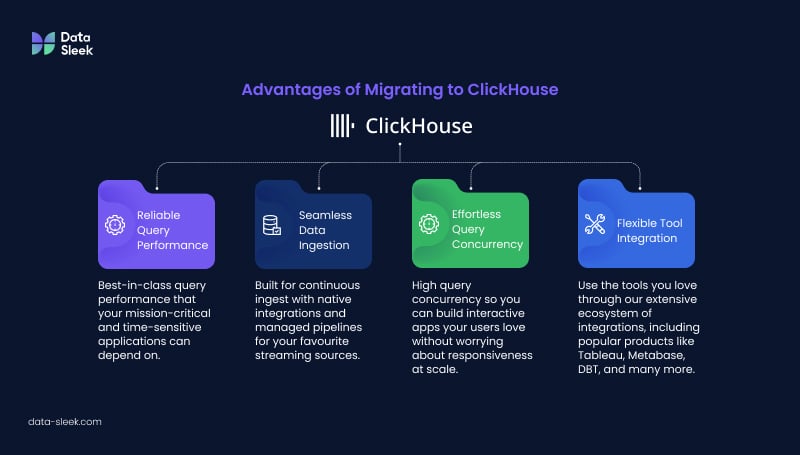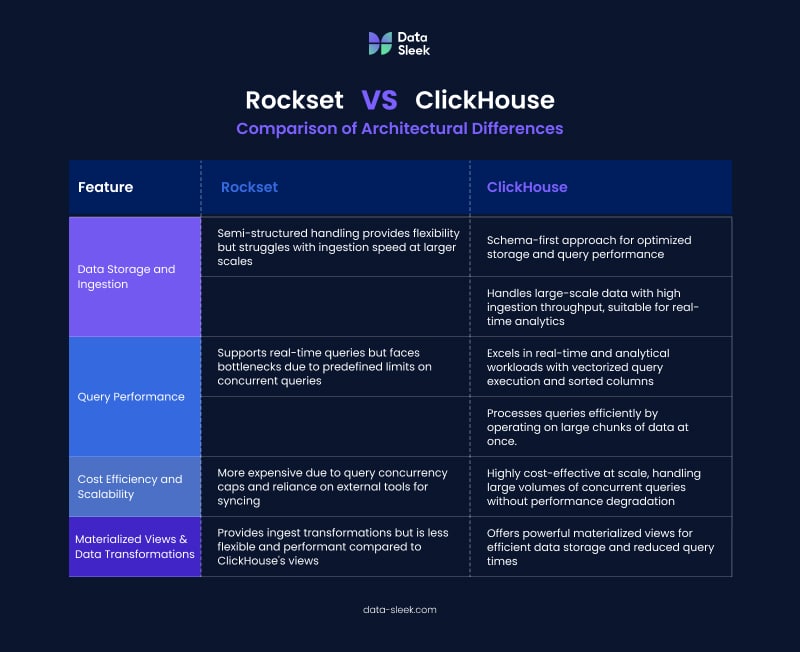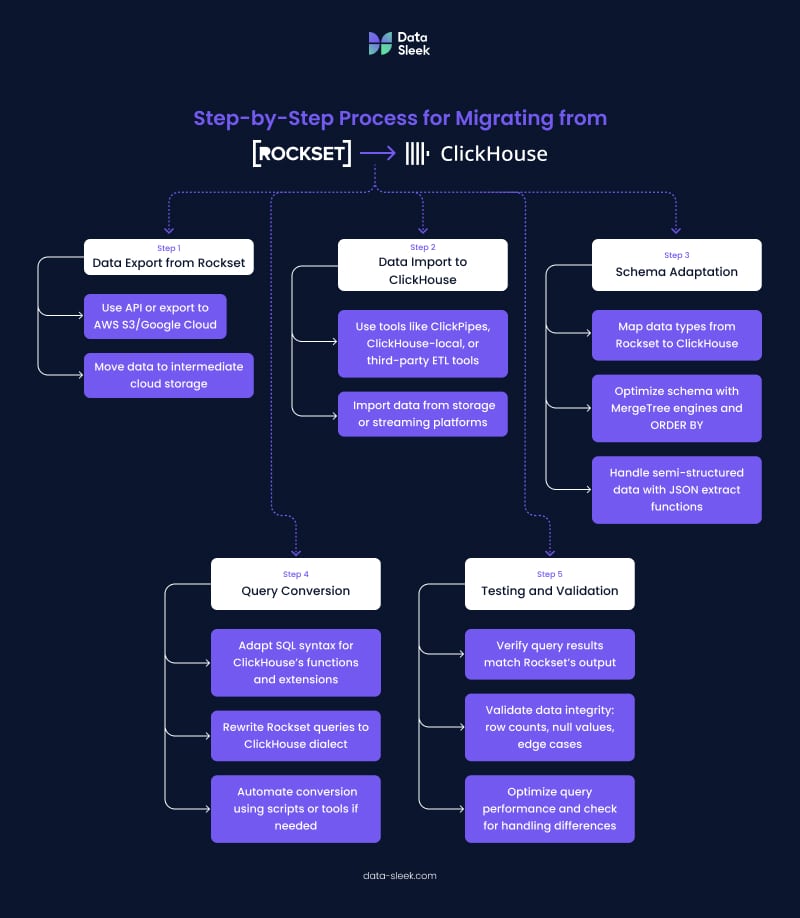With OpenAI’s acquisition of Rockset, many organizations are scrambling to find alternatives for their real-time analytics needs. ClickHouse stands out as a powerful option that not only matches many of Rockset’s capabilities but excels with superior performance for analytical workloads and cost-effective scalability.
This guide walks through how to complete a Rockset migration to ClickHouse, highlighting key differences and advantages to help you leverage ClickHouse’s unique strengths after migration.

Why ClickHouse Makes Sense for Rockset Users
The jump from Rockset to ClickHouse is more straightforward than you might expect. These platforms share enough common ground to make migration feasible:
1. Flexible Data Ingestion
Both platforms integrate well with existing data ecosystems — whether you’re pulling from Kafka, S3, MySQL, or MongoDB. ClickHouse provides multiple ingestion options including batch loading, streaming via Kafka integration, and built-in replication. While Rockset emphasizes real-time ingestion, ClickHouse compensates with its columnar storage format that delivers exceptional compression and performance for analytical queries.
2. Adaptable Data Structures
Transitioning from Rockset’s collections to ClickHouse’s columnar format requires some adjustment in thinking. This architectural difference demands thoughtful schema design during migration but delivers substantial performance benefits for analytics workloads. Your transformation logic can largely carry over with modifications to match ClickHouse’s SQL dialect.

3. Robust Query Capabilities
Rockset’s Query Lambdas have served many organizations well, but ClickHouse’s SQL capabilities stand strong with specialized extensions built for analytical processing. Its vectorized query execution tears through large datasets with impressive efficiency, while specialized aggregation functions deliver the insights you need. ClickHouse also offers full-text search capabilities through purpose-built engines.
4. Built for Scale
ClickHouse was designed from day one as a distributed database system. Its sharding and replication architecture distributes both data and processing across clusters, delivering impressive horizontal scalability. As analytics requirements grow, ClickHouse grows too, often at a fraction of the cost of commercial alternatives.
5. Deployment Flexibility
For organizations tired of being locked into AWS, ClickHouse provides breathing room with deployment options spanning cloud providers, on-premises setups, and hybrid approaches. This flexibility creates advantages both during migration and as infrastructure needs evolve.
ClickHouse vs. Rockset: Key Differences
Before diving into migration details, it’s worth understanding where ClickHouse truly shines compared to Rockset:
The Ingestion Approach
Rockset built its reputation on seamless real-time processing and handling complex JSON without schema definitions. ClickHouse takes a different approach — asking more upfront in terms of schema design but rewarding users with remarkable analytical performance. With thoughtful data modeling, ClickHouse delivers exceptional results for analytical workloads.
Analytics-Optimized Performance
Rockset excels at low-latency search operations through its Converged Index. ClickHouse takes a different path to performance, optimizing relentlessly for analytical queries across massive datasets. Its columnar storage and vectorized execution shine brightest when aggregating billions of rows or analyzing patterns across terabytes of data. For true analytical workloads, ClickHouse delivers standout performance where it counts.
Cost-Effective Scaling
Both platforms approach scalability differently. Rockset cleanly separates compute and storage but can struggle with large concurrent workloads as datasets grow. ClickHouse’s distributed architecture takes a more direct approach, spreading data across commodity hardware to achieve impressive scale without premium pricing. This shared-nothing design means analytics platforms can grow organically with data needs.
Analytics Depth
ClickHouse excels as an analytical engine with specialized functions for data warehousing and business intelligence. Its native support for complex aggregations, statistical analysis, and time-series processing delivers insights that would require extra steps in Rockset. While users might miss Rockset’s vector search capabilities in some use cases, ClickHouse’s analytical depth compensates for many workloads.

Open Source Advantage
Perhaps the most significant difference is philosophical — ClickHouse’s open-source nature brings tangible benefits. Beyond potential cost savings, users gain access to rapid community innovation, freedom from vendor lock-in, and deployment flexibility. The thriving ecosystem around ClickHouse means organizations aren’t alone when facing challenges.
The Migration Roadmap
Breaking down the Rockset to ClickHouse migration into manageable steps:
1. Prepare Your Data
Start by exporting Rockset collections to cloud storage — S3, GCS, or Azure Blob all work well. For structured data, formats like CSV or Parquet offer the smoothest path forward. For JSON or nested structures, you’ll need to plan schema transformations as part of the export process.
2. Design Your Schema
This step marks a critical transition. Rockset’s schemaless approach offers flexibility, but ClickHouse rewards intentional schema design. Consider these key decisions:
- Choose table engines that match access patterns
- Set up smart partitioning for time-series data
- Design primary keys that support common queries
- Plan materialized views to accelerate repeated query patterns
- Leverage specialized column types for efficiency
Taking time here pays massive dividends later. A thoughtful schema design often makes the difference between adequate and exceptional performance.
3. Configure Data Ingestion
ClickHouse provides several options for data ingestion:
- Use the command-line client or HTTP interface for bulk loading
- Set up Kafka connectors for continuous data streams
- Configure replication for resilience
- Implement materialized views for on-ingest transformations
- Consider using table engines that directly query object storage
For large migrations, a staged approach using S3 or similar storage as an intermediate step often proves most reliable, allowing data validation before final ingestion.

4. Transform Your Queries
This step goes beyond simple translation. Rockset Query Lambdas need thoughtful adaptation for ClickHouse’s environment:
- Adapt to ClickHouse’s SQL dialect and specialized functions
- Leverage its powerful aggregation capabilities
- Design materialized views for complex query patterns
- Implement appropriate indexing strategies
- Rethink JSON handling using ClickHouse’s native functions
Don’t just port queries — reimagine them to take advantage of ClickHouse’s columnar architecture and analytical strengths.
5. Test, Measure, Optimize
With data flowing and queries running, it’s time to fine-tune performance:
- Use EXPLAIN to understand query execution
- Monitor system tables to identify bottlenecks
- Revisit schema decisions based on real-world usage
- Add materialized views where they deliver value
- Adjust server configurations to match workload profiles
Real-world testing against actual query patterns is irreplaceable. Be prepared to iterate to learn what works best for your specific needs.
6. Secure Your Environment
With performance optimized, securing the new environment becomes crucial:
- Set up users with appropriate privileges
- Implement role-based access controls
- Configure network security measures
- Enable encryption for data in transit
- Set up data encryption at rest for sensitive information
Security isn’t optional — especially in production environments handling sensitive data.
Common Migration Challenges
Even with careful planning, migrating from Rockset to ClickHouse comes with its share of hurdles:
SQL Dialect Differences
ClickHouse speaks SQL, but with its own dialect and specialized functions. Queries that worked seamlessly in Rockset might need significant rethinking, especially those leveraging Rockset-specific features or deeply nested JSON paths.
Schema Design Learning Curve
After Rockset’s schemaless flexibility, ClickHouse’s need for upfront schema decisions can feel restrictive. Getting partitioning, primary keys, and table engines right takes experience, and mistakes here can dramatically impact performance.
Pipeline Reconfiguration
Existing data flows will need adjustment. ClickHouse ingests data differently than Rockset, and adapting existing pipelines requires careful planning, especially for real-time data streams.
Performance Tuning Requirements
ClickHouse optimization differs fundamentally from Rockset. Understanding how to leverage columnar storage, materialized views, and specialized engines comes with a learning curve that shouldn’t be underestimated.
Data Consistency Considerations
Ensuring data integrity during migration, particularly with complex schemas or continuous data flows, demands meticulous planning and validation to prevent gaps or inconsistencies.
Expert Migration Support
Many organizations benefit from experienced guidance during database migrations. Teams of experienced data engineers can help navigate the shift from Rockset to alternatives like ClickHouse.
Expert help can determine if ClickHouse aligns with your specific needs or suggest better alternatives based on unique requirements. With experienced support, organizations can avoid common pitfalls and accelerate migration timelines.
Don’t let uncertainty stall your plans. A consultation can help discuss Rockset migration options and keep analytics capabilities moving forward.
Frequently Asked Questions
Can ClickHouse handle real-time analytics like Rockset?
While ClickHouse wasn’t originally built for real-time processing like Rockset, it has evolved significantly. With proper streaming integrations through Kafka and thoughtful architecture, it can deliver near real-time analytics for many use cases. The tradeoff is that more careful design is needed compared to Rockset’s out-of-the-box real-time capabilities.
How will JSON and time-series data fare in ClickHouse?
ClickHouse handles both data types well, but differently than Rockset. JSON support comes through specialized functions and a native JSON type, while time-series data benefits from ClickHouse’s efficient storage and purpose-built functions. The key is designing schemas to optimize for these data types rather than expecting identical behavior to Rockset’s schemaless approach.
What about Clickhouse high-concurrency workloads?
ClickHouse prioritizes analytical throughput over handling thousands of small concurrent transactions. While it can support numerous concurrent analytical queries, environments with extreme connection, concurrency will require more careful resource management compared to OLTP-focused systems.
How does Clickhouse cost compare to Rockset?
As open-source software, ClickHouse typically offers substantial cost advantages against Rockset’s commercial pricing, especially at scale. Self-managed ClickHouse requires operational expertise, but the total cost of ownership usually comes in lower for large deployments. Cloud-managed options provide various price points depending on needs and provider.
Will BI tools still work?
Most likely, yes. ClickHouse integrates with popular BI platforms through standard interfaces and connectors. Tools like Tableau, Power BI, Looker, and Superset all work well with ClickHouse, letting organizations preserve existing visualization and reporting investments after migration.



